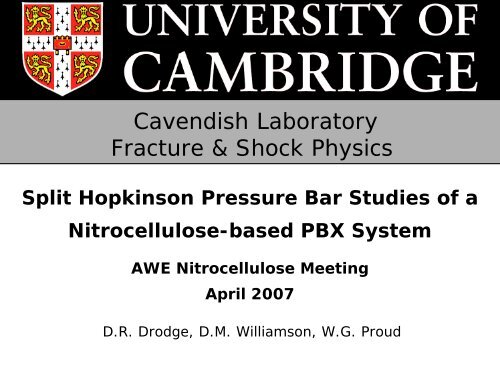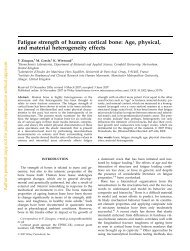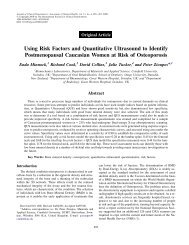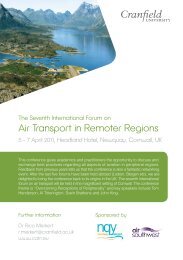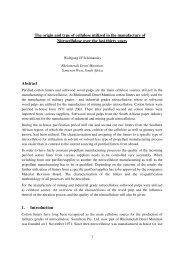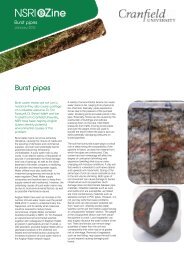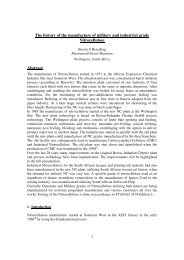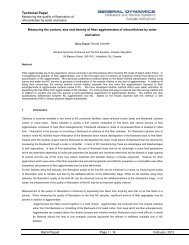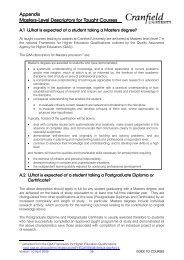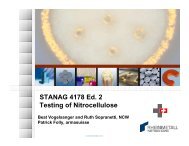Split Hopkinson Bar Studies
Split Hopkinson Bar Studies
Split Hopkinson Bar Studies
You also want an ePaper? Increase the reach of your titles
YUMPU automatically turns print PDFs into web optimized ePapers that Google loves.
Cavendish Laboratory<br />
Fracture & Shock Physics<br />
<strong>Split</strong> <strong>Hopkinson</strong> Pressure <strong>Bar</strong> <strong>Studies</strong> of a<br />
Nitrocellulose-based PBX System<br />
AWE Nitrocellulose Meeting<br />
April 2007<br />
D.R. Drodge, D.M. Williamson, W.G. Proud<br />
1
Overview<br />
Materials: EDC37 and NC-K10<br />
Technique: <strong>Split</strong>-<strong>Hopkinson</strong> Pressure<br />
<strong>Bar</strong> with Pulse Shaping and<br />
Temperature Control.<br />
Results & Discussion<br />
2
Sample Materials<br />
3
EDC37: 91% HMX<br />
filler, 9% NC-K10<br />
binder<br />
NC-K10: plasticised<br />
nitrocellulose<br />
Motivation: examine<br />
sub-T g behaviour<br />
to extend current<br />
data set.<br />
Sample Materials<br />
DMTA figure courtesy of Dr D. Williamson<br />
4
Story So Far<br />
We already have EDC37 data for:<br />
Fixed T (room temp), varying strain<br />
rates<br />
Fixed strain rate (10 -3 s -1 ), varying T<br />
(D.M. Williamson et. al., paper awaiting publication)<br />
… ramp up strain rate, drop T, see what<br />
happens…<br />
5
Storage Modulus<br />
Viscoelastic Response<br />
Glassy<br />
T g Transition<br />
Rubbery<br />
Melt<br />
Temperature OR Loading Time Period<br />
6
Not-so-subtle differences…<br />
Strain Rate vs. Loading Frequency<br />
Small strain vs. strained to failure<br />
Pure polymer vs. filled polymer…<br />
F 0 sin(wt)<br />
THUD!<br />
1T<br />
7
Storage Modulus<br />
Current Data…<br />
Glassy<br />
T g Transition<br />
Rubbery<br />
Melt<br />
Temperature OR Loading Time Period<br />
8
Plan…<br />
Use high strain-rate apparatus to<br />
raise the transition temperature<br />
Use cooling chamber to induce<br />
glassy behaviour<br />
Find something out.<br />
9
Apparatus<br />
10
<strong>Split</strong> <strong>Hopkinson</strong> Pressure <strong>Bar</strong><br />
Sample<br />
Striker Input Output Trapper<br />
Gauges measure strain in <strong>Bar</strong>s<br />
11
<strong>Split</strong> <strong>Hopkinson</strong> Pressure <strong>Bar</strong><br />
Striker Input Output Trapper<br />
Particle<br />
Velocity<br />
Sample<br />
Gauges measure strain in <strong>Bar</strong>s<br />
Z<br />
SAMPLE STRAIN<br />
Strain<br />
E<br />
Stress<br />
Sample Dim’s<br />
A<br />
Force<br />
SAMPLE STRESS<br />
12
<strong>Split</strong> <strong>Hopkinson</strong> Pressure <strong>Bar</strong><br />
Gauge Voltage / V<br />
0.5<br />
0.4<br />
0.3<br />
0.2<br />
0.1<br />
0<br />
-0.1<br />
-0.2<br />
-0.3<br />
60 110 160 210 260 310 360<br />
Time / microseconds<br />
Input Gauge<br />
Output Gauge<br />
13
<strong>Split</strong> <strong>Hopkinson</strong> Pressure <strong>Bar</strong><br />
Gauge Voltage / V<br />
0.5<br />
0.4<br />
0.3<br />
0.2<br />
0.1<br />
0<br />
-0.1<br />
-0.2<br />
-0.3<br />
Incident<br />
Transmitted<br />
60 110 160 210 260 310 360<br />
Time / microseconds<br />
Input Gauge<br />
Output Gauge<br />
Reflected<br />
14
<strong>Split</strong> <strong>Hopkinson</strong> Pressure <strong>Bar</strong><br />
Gauge Voltage / V<br />
0.5<br />
0.4<br />
0.3<br />
0.2<br />
0.1<br />
-0.1<br />
-0.2<br />
-0.3<br />
Incident<br />
0<br />
60 110 160 210 260 310 360<br />
F I<br />
F R<br />
v L<br />
Transmitted<br />
Time / microseconds<br />
L<br />
v R<br />
F T<br />
Input Gauge<br />
Output Gauge<br />
Reflected<br />
15
<strong>Split</strong> <strong>Hopkinson</strong> Pressure <strong>Bar</strong><br />
ε&<br />
=<br />
vR − vL<br />
L<br />
F I<br />
F R<br />
v L<br />
L<br />
v R<br />
F T<br />
σ =<br />
F<br />
A<br />
(assumes equilibrium)<br />
T<br />
S<br />
16
<strong>Split</strong> <strong>Hopkinson</strong> Pressure <strong>Bar</strong><br />
σ<br />
σ<br />
L<br />
R<br />
=<br />
=<br />
F<br />
A<br />
T<br />
S<br />
F I +<br />
A<br />
S<br />
F<br />
R<br />
F I<br />
F R<br />
v L<br />
L<br />
Do Front and Back<br />
v R<br />
stresses match?<br />
…if not, we have a problem<br />
F T<br />
17
<strong>Split</strong> <strong>Hopkinson</strong> Pressure <strong>Bar</strong><br />
Shallower Pulses = Reach Equilibrium Sooner<br />
Copper Shim (annealed at 450C for 2hrs)<br />
Place on end of input bar to cushion blow<br />
Strain<br />
0 20 40 60 80 100 120<br />
Time / μs<br />
18
<strong>Split</strong> <strong>Hopkinson</strong> Pressure <strong>Bar</strong><br />
5000<br />
4000<br />
3000<br />
2000<br />
1000<br />
0<br />
-1000<br />
-2000<br />
-3000<br />
-4000<br />
Smoothed Pulse (timeshifted)<br />
Reflected Force<br />
0 20 40 60 80 100 120 140<br />
Transmitted Force<br />
Incident Force<br />
Two-Wave Force<br />
19
Other considerations<br />
Friction. Mitigate by lubrication with<br />
appropriate substance (silicon<br />
grease)<br />
Inertia. Demonstrated* to be<br />
negligible for strain rates below<br />
105s-1 provided sample geometry is<br />
sensible.<br />
*G.T. Gray III (2000) – ASM Handbook vol. 8<br />
20
Heating / Cooling System<br />
Thermocouple on output bar.<br />
21
Heating / Cooling System<br />
22
3mm Length<br />
8mm Diameter<br />
EDC37 Samples<br />
Supplied in disc form by AWE<br />
23
NC-K10 Samples<br />
Supplied as ~1mm thick sheets by AWE<br />
Make double-thickness sheet<br />
Punch out ~3mm diameter discs<br />
Place between lubricated bars and<br />
squeeze<br />
Measure dimensions using<br />
sophisticated multichromatic<br />
photometric array<br />
24
NC-K10 Samples<br />
25
NC-K10 Samples<br />
Obtain height and width.<br />
Thickness well defined…<br />
Diameter less so… hence<br />
stress is subject to error<br />
26
Results<br />
27
EDC37 Results<br />
28
Near-constant failure strain<br />
Failure<br />
29
EDC37 Results<br />
30
EDC37 Strength<br />
31
EDC37 Strength<br />
Glassy?<br />
Glass<br />
Transition<br />
Rubbery<br />
32
EDC37 Modulus Estimate<br />
Usually, elastic behaviour occurs<br />
before sample equilibrium reached<br />
Pulse Shaping allows earlier<br />
equilibrium<br />
Stress-strain gradient offers<br />
estimate of elastic modulus<br />
33
EDC37 Modulus Estimate<br />
34
EDC37 Modulus Estimate<br />
Glassy<br />
?<br />
T g Transition<br />
Rubbery<br />
35
NC-K10 Results<br />
36
NC-K10 Results<br />
“Yield Stress” taken as zero for “melt”<br />
Stresses have near 10% error from poorly defined<br />
sample diameter/area<br />
37
Combined Strength Results<br />
38
Combined Strength Results<br />
Lower T g ??<br />
Bizarre shape<br />
39
Conclusions<br />
<strong>Hopkinson</strong> <strong>Bar</strong>s allow detailed study of<br />
viscoelastic effects in high rate impact<br />
around the glass transition<br />
EDC37 Failure Stress continues to rise<br />
below T g<br />
High rate modulus estimates describe a<br />
near-ideal viscoelastic master curve at<br />
low strains<br />
NC-K10 Failure Stress peaks at<br />
T ~ -60C, then decreases<br />
Binder transition at lower T than EDC37,<br />
sharper<br />
40
Extension<br />
Cold machining to produce better<br />
NC-K10 specimens from new<br />
material<br />
High-speed photography and softrecovery<br />
techniques to confirm<br />
failure modes<br />
Simultaneous diametric<br />
measurements to find Poisson’s<br />
Ratio<br />
Investigate crystal behaviour at low<br />
temperatures<br />
41
Acknowledgments<br />
D.R. Drodge and D.M. Williamson<br />
thank AWE<br />
W.G. Proud thanks QinetiQ<br />
42


